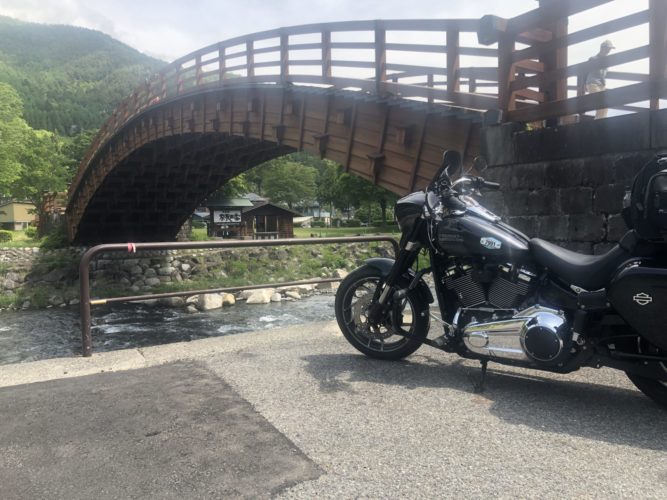Hello, this is _hiroyuki.ta. This time, I toured Narai-juku, a historical post town on Nakasendo in Nagano Prefecture, on a Harley Sports Glide (FLSB). Narai-juku is a post town that flourished during the Edo period and was so bustling that it was called “Narai Sengen,” and is still designated as a nationally important preservation district for groups of traditional buildings. It is the highest point on the Kisoji Route and is close to the difficult Torii Pass, so it is sometimes covered with snow in the winter, but from spring to fall it is crowded with tourists and motorbike riders. This time, we will introduce the route from central Tokyo to Narai-juku, highlights, motorcycle parking, etc.
What is Naraijuku?

Narai-juku is one of the 67 Nakasendo-juku stations (from Itabashi to Moriyama), excluding Kusatsu and Otsu-juku, which are shared with the Tokaido, and Narai-juku is from Itabashi-juku on the Edo side. It is a post town located exactly in the middle of Nakasendo, and is the 34th post town if you count from Moriyama-juku on the Kyoto side. The post town, which is the highest among the 11 Kiso post stations and located near the difficult Torii Pass, flourished with many travelers and was hailed as Narai Sengen.'' The townscape has been selected as a nationally important preservation district for groups of traditional buildings, and retains a strong vestige of the past. This post station, which has won many awards, is also the setting for the TV drama seriesOhisama” and is visited by many people from Japan and abroad every year as a place where you can feel the true beauty of Japan. I am fascinated by historical post stations.
Route to Narai-juku
This time, I toured from central Tokyo to Narai-juku on a Harley Sports Glide (FLSB). Below is the route I ran.
- From central Tokyo, take the Shuto Expressway and enter the Tomei Expressway.
- Continue on the Tomei Expressway and exit at Numazu IC.
- Proceed west on National Route 1.
- We will take a break at Fujikawa SA.
- Enter National Route 52 from National Route 1.
- Go north on National Route 52 and enter the Chuo Expressway at Fujikawa IC.
- Continue on the Chuo Expressway and exit at Shiojiri IC.
- Go south on National Route 19 and turn left at the Narai Kiso Ohashi intersection.
- We will arrive at the roadside station Narai-juku located behind Narai Station.
This route is about 300km and takes about 5 hours.
Highlights of Naraijuku

Narai-juku has many attractions where you can feel the atmosphere of the Edo period. I will introduce some of them below.
- Townscape: The townscape of Narai-juku stretches for about 1km from north to south along National Route 19. There are shrines on both the north and south ends of the townscape, and five temples are located at the foot of the mountain behind the town. In the townscape, there were honjin, waki honjin, and wholesalers. Most of the buildings are mezzanine stories, with the lower second floor extending over the entire surface as an edge, with a gently sloping roof and deep eaves. The roofs used to be made of stone, but today they are mostly made of iron sheets. Some have side walls in front of the second floor, creating a varied streetscape. Walking through the townscape will make you feel like you have traveled back in time to the Edo period.
- Kiso Ohashi Bridge: This bridge spans the Kiso River at the southern end of Narai-juku. The Kiso River is considered the most difficult point on the Nakasendo route, and many travelers have had difficulty crossing it. Ferry boats and rafts were used during the Edo period, but wooden bridges were built for the first time in the Meiji period. Since then, it has been washed away and burnt down many times due to floods and fires, but the current bridge was built in the 1950s and has a total length of about 200 meters. From the bridge, you can see the Kiso River and the townscape of Narai-juku.
- Chin Shrine: This shrine is located at the northern end of Narai-juku. It is worshiped as the local deity of Narai-juku, and the grounds include the main shrine, worship hall, and torii gate built in the Edo period.
Naraijuku motorcycle parking lot
Narai-juku has a parking lot that is great for motorcyclists. I will introduce them below.
- Roadside Station Nara Nara Kiso Ohashi: There is also a free motorcycle parking lot along the Kiso River at the southern end of Narai-juku. You can see the Kiso River and Kiso Ohashi Bridge from here.
Summary
This time, I toured from central Tokyo to Narai-juku in Nagano Prefecture on a Harley Sports Glide (FLSB). Narai-juku is a historical post town that retains the atmosphere of the Edo period, and we were able to explore the townscape, shrines, bridges, and more. It is also a convenient tourist destination for motorcyclists as there is free parking available for motorbikes. Narai-juku is a wonderful place where you can feel the beauty of Japan. Please come and visit us at least once.
Narai-juku (English: Narai-juku)



